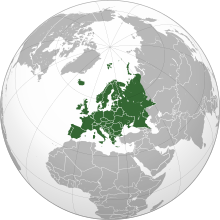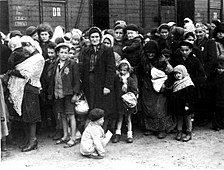
Back تاريخ اليهود في أوروبا Arabic Židé v evropských zemích Czech تاریخ یهودیان در اروپا Persian Juifs et judaïsme en Europe French יהדות אירופה HE Storia degli ebrei in Europa Italian História dos judeus na Europa Portuguese История евреев в Европе Russian History of the Jews in Europe SIMPLE Európske židovstvo Slovak

| Part of a series on |
| Jews and Judaism |
|---|
| Part of a series on |
| Antisemitism |
|---|
 |
|
|
| Part of a series on |
| The Holocaust |
|---|
 |
The history of the Jews in Europe spans a period of over two thousand years. Jews, an Israelite tribe from Judea in the Levant,[1][2][3][4] began migrating to Europe just before the rise of the Roman Empire (27 BCE). Although Alexandrian Jews had already migrated to Rome, a notable early event in the history of the Jews in the Roman Empire was the 63 BCE siege of Jerusalem.
Jews have had a significant presence in European cities and countries since the fall of the Roman Empire, including Italy, Spain, Portugal, France, the Netherlands, Germany, Poland, and Russia. In Spain and Portugal in the late fifteenth century, the monarchies forced Jews to either convert to Christianity or leave and they established offices of the Inquisition to enforce Catholic orthodoxy of converted Jews. These actions shattered Jewish life in Iberia and saw mass migration of Sephardic Jews to escape religious persecution. Many resettled in the Netherlands and re-judaized, starting in the late sixteenth and early seventeenth centuries. In the religiously tolerant, Protestant Dutch Republic Amsterdam prospered economically and as a center of Jewish cultural life, the "Dutch Jerusalem". Ashkenazi Jews lived in communities under continuous rabbinic authority. In Europe Jewish communities were largely self-governing autonomous under Christian rulers, usually with restrictions on residence and economic activities. In Poland, from 1264 (from 1569 also in Lithuania as part of the Polish-Lithuanian Commonwealth), under the Statute of Kalisz until the partitions of the Polish-Lithuanian Commonwealth in 1795, Jews were guaranteed legal rights and privileges. The law in Poland after 1264 (in the Polish-Lithuanian Commonwealth in consequence) toward Jews was one of the most inclusive in Europe. The French Revolution removed legal restrictions on Jews, making them full citizens. Napoleon implemented Jewish emancipation as his armies conquered much of Europe. Emancipation often brought more opportunities for Jews and many integrated into larger European society and became more secular rather remaining in cohesive Jewish communities.
The pre-World War II Jewish population of Europe is estimated to have been close to 9 million,[5] or 57% of the world's Jewish population.[6] Around 6 million Jews were killed in the Holocaust, which was followed by the emigration of much of the surviving population.[7][8][9]
The Jewish population of Europe in 2010 was estimated to be approximately 1.4 million (0.2% of the European population), or 10% of the world's Jewish population.[6] In the 21st century, France has the largest Jewish population in Europe,[6][10] followed by the United Kingdom, Germany, Russia and Ukraine.[10] Prior to the Holocaust, Poland had the largest Jewish population in Europe, as a percentage of its population. This was followed by Lithuania, Hungary, Latvia and Romania.[11]
- ^ Jared Diamond (1993). "Who are the Jews?" (PDF). Archived from the original (PDF) on July 21, 2011. Retrieved November 8, 2010. Natural History 102:11 (November 1993): 12–19.
- ^ Hammer, MF; Redd, AJ; Wood, ET; et al. (June 2000). "Jewish and Middle Eastern non-Jewish populations share a common pool of Y-chromosome biallelic haplotypes". Proceedings of the National Academy of Sciences. 97 (12): 6769–6774. Bibcode:2000PNAS...97.6769H. doi:10.1073/pnas.100115997. PMC 18733. PMID 10801975.
- ^ Wade, Nicholas (9 May 2000). "Y Chromosome Bears Witness to Story of the Jewish Diaspora". The New York Times. Retrieved 10 October 2012.
- ^ Shriver, Tony N. Frudakis; with a chapter 1 introduction by Mark D. (2008). Molecular photofitting : predicting ancestry and phenotype using DNA. Amsterdam: Elsevier/Academic Press. ISBN 978-0120884926.
{{cite book}}: CS1 maint: multiple names: authors list (link) CS1 maint: numeric names: authors list (link) - ^ [1] Jewish Gen – The Given Names Data Base, 2013.
- ^ a b c "Europe's Jewish population".
- ^ "Estimated Number of Jews Killed in the Final Solution".
- ^ "Holocaust | Basic questions about the Holocaust". www.projetaladin.org.
- ^ Dawidowicz, Lucy. The War Against the Jews, Bantam, 1986. p. 403
- ^ a b "Jews". Pew Research Center. December 18, 2012.
- ^ "Jewish Population of Europe in 1933: Population Data by Country". Holocaust Encyclopaedia. Retrieved 2023-10-04.
© MMXXIII Rich X Search. We shall prevail. All rights reserved. Rich X Search